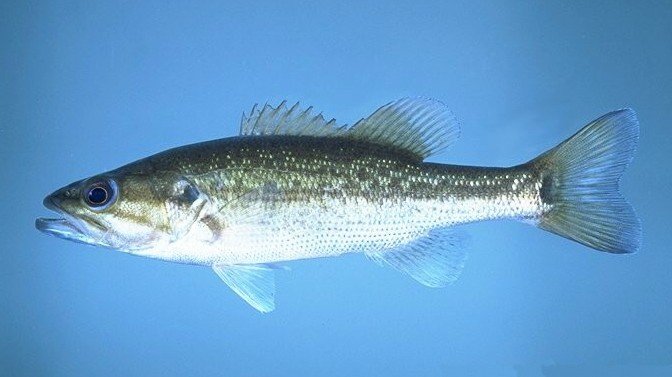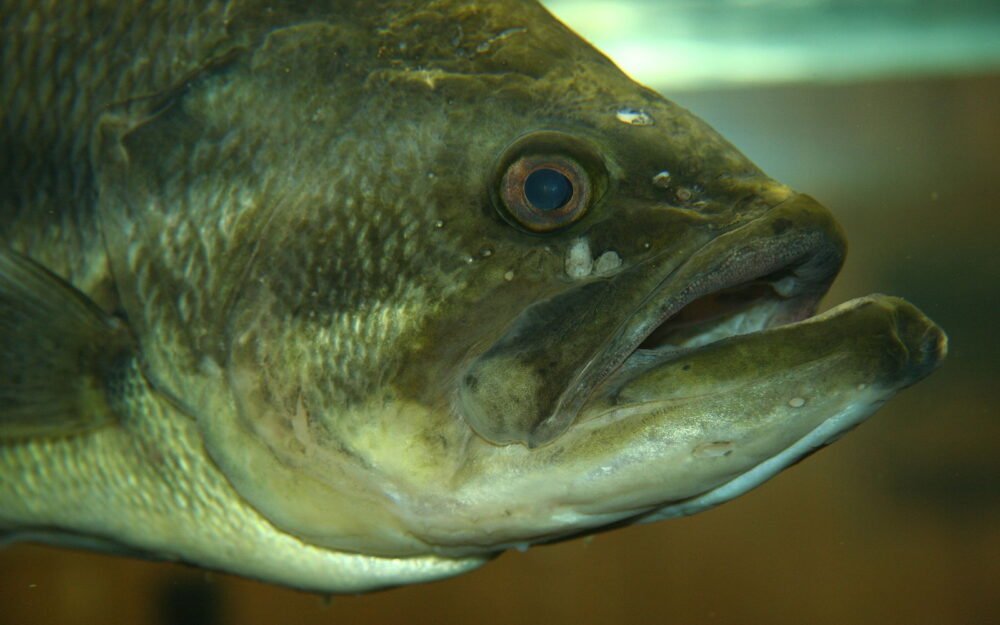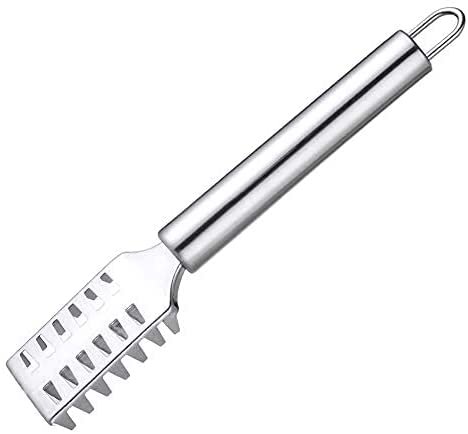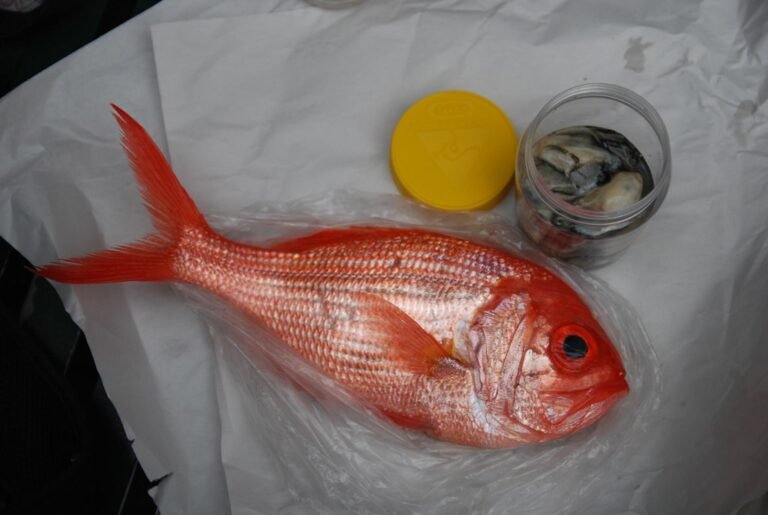Spotted Bass Vs Largemouth Bass

Among the many types of bass, only two are most popular: the Largemouth bass and the Spotted Bass. Both belong to the same family of black bass but are different in several ways including, preferred habitats, size, etc.
Anglers are often separated when it comes to choosing which is better to fish for. Most generally believe that largemouth is better because as the name suggests, they’re larger and easy to catch.
Many others, however, believe that Spotted bass is tastier and better fighters than largemouths. This debate has been for years and certainly will last longer, but fishing for these two species comes with a lot of fun!
What Is A Spotted Bass?

The spotted bass is a freshwater fish that is found in the United States. They are a type of black bass and are related to their largemouth counterparts. The dark spots on their light-colored body distinguish them from all other black basses.
Characterized by their combating strength and delicious taste, the spotted bass is commonly concentrated in clear water reservoirs and rivers, and they typically grow in length to about 24 inches.
They depend on crayfish, insects, and small fish for food. They like to feed when it’s dark, and prefer water with lots of structural cover like rocks and plants, and moderate current. The following are the spotted bass’ subspecies:
1 – The Northern Spotted Bass
This subspecies of freshwater spotted brass is usually found in the United States. Like the typical spotted bass they are, they have dark spots all over their body and are usually olive or brown.
They’re known to be good sport fish. They’re also popular for their combating power and can grow up to a size of 10 pounds.
2 – The Alabama Spotted Bass
The Alabama Spotted Bass is native to the eastern United States waters. Commonly found in the Alabama River and its tributaries. In addition, they’re also found in the other parts of the southeastern US.
This subspecies of Spotted Bass is popular in fish gaming. They are good game fish and are used for sports as well as broodstock in hatcheries. Easily caught on baits that mimic baitfish, such as jerk baits and crankbaits
3 – The Wichita Spotted Bass
The Wichita Spotted Bass is a type of freshwater fish, located in the Wichita Mountains of Oklahoma, USA. They are part of the sunfish family. Found in reservoirs and streams, they can grow to about 10 inches in length.
They also have dark spots on their body. A popular game fish due to their fight power.
What Is A Largemouth Bass?

Largemouth Bass, on the other hand, is a type of fish that is naturally found in North America. Found in shallow, warm, waters like rivers and lakes, they’re popular as game fish and their fighting power with which they devour their prey.
They can grow in weight up to 20 pounds. Largemouths have a typical brown or olive-green color with swarthy streaks running along the sides of their body.
With a wide, flattened head and largemouth capable of downing up to half of their prey’s size at a go. Being a bottom feeder, the Largemouth bass has a diet consisting of insects, mollusks, crustaceans, worms, and amphibians.
They’re a delicious food fish that can be enjoyed fried, grilled, or smoked. Below are the subspecies of the largemouth bass:
1 – The Northern Largemouth
As a subspecies of the Largemouth bass, the Northern Largemouth is commonly found in the US and Canada. Originally, they’re native to the Great Lakes but have received an introduction to other water parts of North America.
Olive green or brown skin with black markings is their characteristic color. They are popular in sport fishing, considered delicious for eating, and grow in length up to about 24 inches.
2 – Florida Largemouth
Like their Northern Largemouth counterpart, Florida Largemouths are popular in-game fishing for their fighting power and are also known for their delicious flesh.
They are found in many rivers and lakes throughout the state of Florida. They can grow in length up to 3 feet and can measure up to 20 pounds in weight. Unlike their Northern Largemouth counterpart, they possess smaller scales and grow faster too.
How To Easily Identify A Spotted Bass?
Spotted bass (Micropterus punctulatus) is a species of freshwater fish whose native source is in the United States. Popular as game fish, most anglers often seek to catch them.
They are characterized by their special dark spots varying in number and size. With their typical green or bronze color, they can grow in length up to 24 inches. They are characterized by a narrow, deep body and a large head with a lower jaw extending further than the upper jaw.
They are typically caught at the size between 1 and 2 pounds, although they have the potential to hit 10 pounds weight.
With few teeth, Spotted bass feed on small invertebrates and plankton. Their dorsal find is fused unlike largemouths’ that are not. Spotted bass also has a coarse rectangular patch at the center of their tongue.
How To Easily Identify A Largemouth Bass?
The Largemouth bass (Micropterus salmoides) are known for their characteristic black or green color with a greenish hue. They also possess, on their body, a noticeably large dark spot on their body. These fish can weigh as much as 20 pounds and can grow in length to about 25 inches.
Moreover, they’re known to be the only bass type with a wide mouth extending to as far as their eyes. This mouth is large enough to swallow up to half of its prey’s size. Largemouths are also vicious fighters.
They fight excellently whenever they sense any form of threat. Unlike their spotted bass counterparts, they possess smooth tongues.
Habitats
The Largemouth bass and the Spotted bass don’t share the same habitat. Although they both are freshwater fishes, largemouth bass is also found in saltwater.
The deep, cold waters of the North Atlantic are the natural habitat of the spotted bass, whereas the Largemouths can be discovered in rivers and lakes all around the world, both seasonal and permanent water bodies.
Subspecies
Just as other animals on earth, the Largemouth bass and spotted bass have subspecies that majorly differ in behavior, morphology, and where they dwell.
Behavioral Differences
Although both fishes are freshwater members of the black bass family, they exhibit distinct behavioral differences.
The Largemouth bass is found in darker water than spotted bass which is found in clearer water.
Spotted Bass are more likely to be found in smaller creeks and streams while largemouth are in larger reservoirs and lakes.
Largemouth bass jump and rush to the water surface when hooked whereas spotted bass tends to pull back and dive deeper down the water when caught by a hook.
Spotted bass tends to associate around structures whereas largemouths tend to hang out where there is grass, mud, and vegetation.
Which One Is Better To Fish For?
In fishing for bass, anglers all around the country often chase these two species: the spotted and the largemouth. Choosing which one is the better to fish for comes with a little complication. Each species comes with its pros and cons, and the choice of the better to fish hinges on the anglers’ preferences.
Below are a few points to note:
- Largemouth bass, the largest among the bass species, grows long enough, up to 24 inches. Most anglers prefer this species because they are fun and easy to catch for sport.
- Anglers who love to fish in large water bodies prefer largemouths because that is where they are typically found.
- Spotted Bass, on the other hand, is colorful and small and grows up to only 10 inches in length. Most anglers prefer to fish this one because of the challenge that comes with catching them.
- Spotted Bass are popularly known for their delicious flesh and fighting power. That is why many anglers like to smoke them.
All these ultimately lead to the preferences of whoever is holding the hook and lure.
Best Fishing Season
Although fishing all year round comes with a lot of fun, to have productive fishing for a particular type of bass varies in a different season of the year.
You can fish spotted bass all through the year and record average productivity. However, to have the best level of productivity, the region in which you’re fishing comes into play.
Spotted bass often dives down, deeper, into the water to get warmer temperature, in the cold climatic region, whereas, they roam in shallow water in a warmer region.
Generally, the best time to catch a largemouth is during warm temperatures, that is, late spring or early summer when the bass are very active and the days run longer. This may, however, differ with location.
Frequently Asked Questions
Are Spotted Bass Endangered?
Some Biological Scientists argue that the Spotted Bass are endangered, whereas others stand on the argument that they are not.
The answer to this question, therefore, is not clear-cut because there are no sure ways to measure their population in waters.
Spotted Bass Is A Hybrid Of What And What?
The debate on whether spotted bass is a hybrid or not has been on for long, and the theory that they are a hybrid is on the winning side.
Many believe that they can only be a hybrid of the largemouth bass and the white bass, whereas others believe that they’re a hybrid of the smallmouth bass and the white bass, both supporting their arguments with tangible pieces of evidence.
The crown, however, most likely falls on the theory that they’re a hybrid of largemouth bass and white bass.
Where Does Spotted Bass Go In The Winter?
Anglers have noticed spotted bass, during winter when the temperature of the waters drop, are difficult to catch like they’re never in the waters. What these fish do or what happens to them during this period remains a mystery to most.
Some believe they travel deeper into the water to escape low temperatures, while some believe they travel to warmer lakes. However, nobody can ascertain for sure because there is not much research on the subject yet.
Is Largemouth Bigger Than Spotted Bass?
The debate over which is larger has been on for years. Generally, the largemouth bass is believed to be the bigger, although the location and age of the fish play a huge factor in this.
What Feeds On The Largemouth Bass?
Every organism has its predators as they have their prey. Starting from the lower life to the larger ones.
The largemouths are not left out. It is also a prey to many water organisms. The predators of largemouth bass include snakes, turtles, raccoons, and other larger fish.
What Does It Mean When Bass Are Spawning?
Bass spawning often occurs during springtime. But what does it mean to say bass spawn?
The word spawning is the process of reproduction for fish. When fish spawn, they reproduce and lay their eggs.
In the case of bass, their spawning lasts for over a certain period of time-several weeks maybe, and not at once.
Bass don’t spawn until the temperature of the water they’re in reaches about 60°F, and this occurs usually around late April or early May.
Can Largemouth And Spotted Bass Interbreed?
Many speculations are going on as to whether these two can breed but there is no substantial proof yet.
There are, however, few instances where scientists put both species in water and they found that through the population, hybrid bass like meanmouth were produced.
Further studies show that their hybrids appear to have more reproductive and growth success than either parent species.
Does Bass Have Teeth?
This is a valid question to ask. Typically, fishes have teeth. However, when it comes to bass, some have and some don’t. The environment and type of bass play an influential role in whether one has or not.
How Do I Know The Sexuality Of A Bass? (Male Vs Female Largemouth Bass)
There are no foolproof methods regarding the determination of the sex of largemouth bass, however, one may use the fish’s body morphology to determine.
In terms of fins, the female bass has thinner, rounded fins whereas the male bass possesses thicker, pointed fins.
In terms of shape, the body of the female bass is less streamlined compared to the male.
In terms of body color, the female bass possesses an olive color, while the males have a yellow or green body.
Do Spotted Bass Have Red Eyes?
Contrary to a popular belief that red eyes are present in all spotted brass, a larger percentage have other types of eye color.
Only in a small percentage will you find red eyes, the rest have either brown or blue eyes.
This misconception is strong since most research on spotted bass has been on those found in the Tennessee River system where fish are major with red eyes.
Do Spotted Bass Have Teeth?
Many people do not believe that spotted bass have teeth. Truly, they do have. They can bite their prey with the help of sharp teeth arrangements.
How Long Do Bass Live?
An average bass has a lifespan between 10 and 12 years. However, they have the potential to live up to about 15 years or more. Bass in the wild even lives longer, to about 20 years. Those in captivity tend not to live as long as those in the wild because they eat less and are not active.






